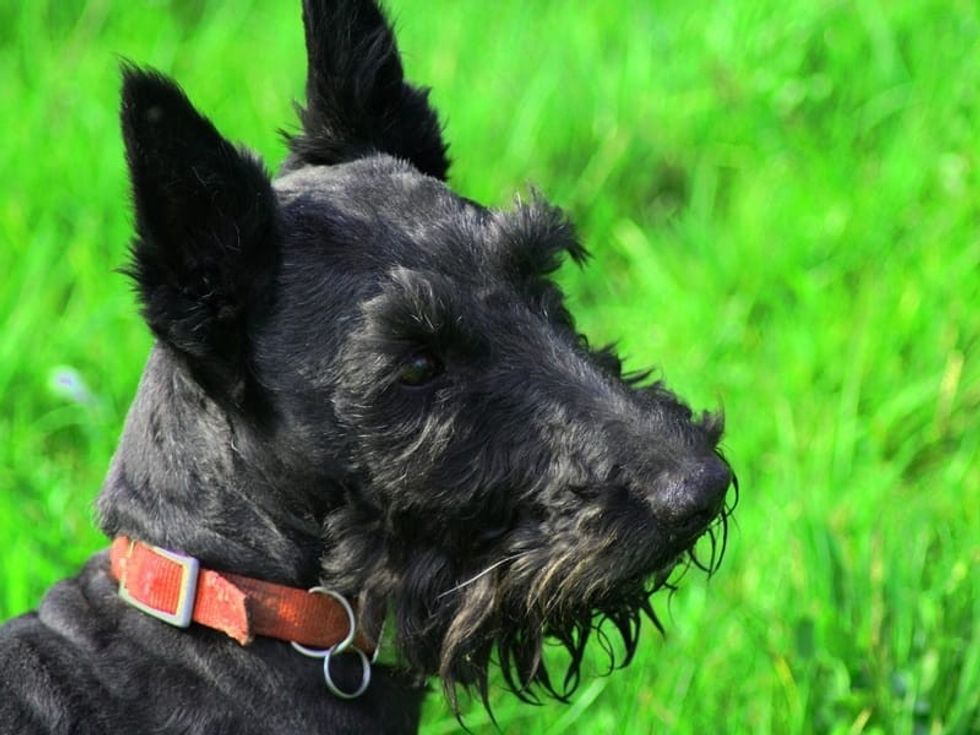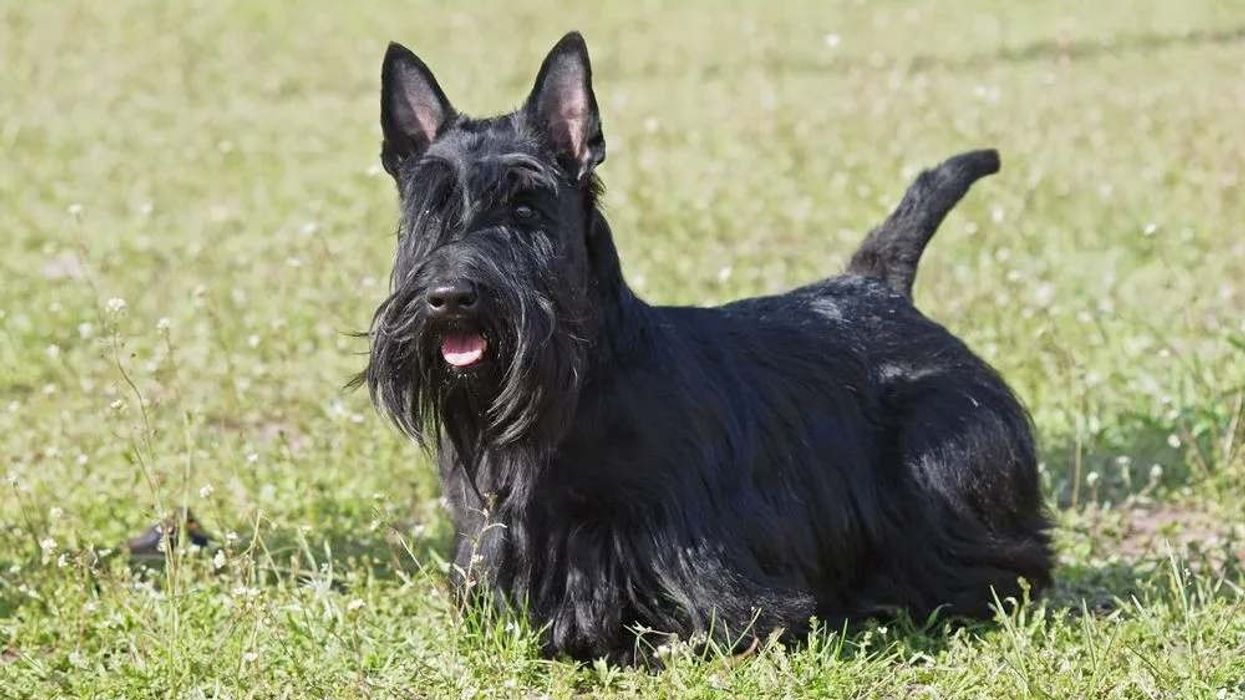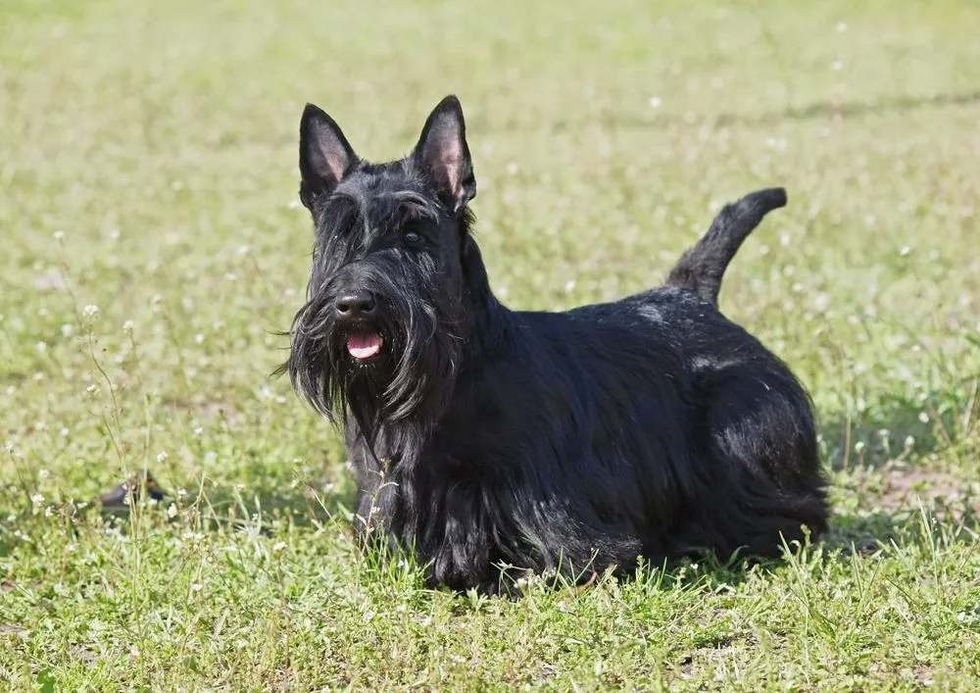Fun Scottish Terrier Facts For Kids
The Scottish Terrier is a short-legged dog with a lot of personality! This dog is one of the oldest breeds of highland terriers that originated in Scotland, along with the five other kinds of terriers.
Fondly called ‘Scotties,’ these little dogs are strong for their size, independent, and very intelligent. They are terriers, which means that they love to dig. They will dig up holes in the backyard if they don’t get enough exercise!
They were bred to be working dogs who helped farmers by taking care of pests like squirrels or foxes. So these dogs have a very strong prey drive, which means that they will chase pests out from your yards as well.
They might even chase the neighborhood cats if you don’t have a fence up! They might also have trouble adjusting to other dogs if they haven’t been socialized properly as puppies.
Scottish Terriers are very loyal and love their families. But they have an aloof temperament with strangers. This makes them excellent watchdogs.
Unlike other small dog breeds, they won’t yap but bark very loudly, which scares most people and creatures away. Additionally, they are very intelligent and do well with training. But they must be treated gently because they are very sensitive.
In this article, you'll find information regarding Scottish Terrier health, Scottish Terrier puppy training, Scottish Terrier breed standard grooming, Scottish Terrier history, Scottish Terrier adult body weight, black Scottish Terrier and giant Scottish Terrier features, and so on.
You may also check out Brazilian terrier facts and Patterdale terrier facts from Kidadl.
Scottish Terrier Interesting Facts
What type of animal is a Scottish Terrier?
A Scottish Terrier is a type of dog known as a terrier.
What class of animal does a Scottish Terrier belong to?
Scottish Terriers are dogs, in the class Mammalia.
How many Scottish Terriers are there in the world?
There is no information about the numbers of Scottish Terriers or Scotties in the world. In 2019, they were put on the Kennel Club’s watchlist because they seemed to be in danger of dying out. Since then, over 256 puppies have been registered in the UK, and the breed is no longer in danger.
Where does a Scottish Terrier live?
Scottish Terriers are dogs that originated in Scotland. They were very popular in the UK and the USA. Now they are found across the world, wherever people keep dogs as pets.
What is a Scottish Terrier's habitat?
Scotties have fur, which has a thick inner coat to keep them warm, and a wiry outer coat. So they are better suited to colder temperatures rather than warm.
Who do Scottish Terriers live with?
Scottish Terriers are pet dogs, which means that they live in homes with the people who own them. They may not be comfortable living with other dogs.
They also have a high prey drive, so they may chase cats. The only way to ensure that they don't chase cats is by making sure that the Scottish Terrier puppies are socialized with cats.
How long does a Scottish Terrier live?
The Scottish Terrier's life span is between 11-13 years.
How do they reproduce?
Scottish Terriers are mammals, which means they reproduce as all mammals do. Female terriers go into heat every six months and have a healthy litter once a year.
What is their conservation status?
Scottish Terriers are dogs, which are classified as Domesticated. This means that there is no immediate threat to the species. This classification does not apply to wild dogs.
Scottish Terrier Fun Facts
What do Scottish Terriers look like?

A Scottish Terrier is a small breed of dog that is short-legged and with a distinctive body shape. Their bodies are square, and they have thick legs.
Their ears are always perked up, and they have almond-shaped eyes. The Scottish Terrier's wiry outer coat of fur is thick and waterproof.
The colors of their outer coat range from black, grayish-black, and wheaten. A wheaten Scottish Terrier may have fur that is anything from straw to almost white, making the dogs look a lot like the West Highland White Terriers. When it comes to the Scottish Terrier shedding, they don't seem to drop as much fur as other breeds.
This is because their fur keeps growing. So Scottish Terrier grooming involves regular clipping and brushing of their coats.
Four to six times a year, they need their haircut. The basic Scottish Terrier haircut is the pet cut or the longer show cut for show dogs.
How cute are they?
Scottish Terriers are absolutely adorable dogs. Their small body size, soft wiry fur, perky ears, and bright eyes make the Scotties look unbelievably cute.
They are also an intelligent breed of dog and very independent. They have a lot of personality and a high energy level. These dogs are also very gentle with children and the elderly, which, along with the Scottish Terrier size, makes them even cuter!
How do they communicate?
Dogs communicate in a variety of ways, including barks, whines, and howls. Scottish Terriers may not bark as often as other small dog breeds. However, they do bark when they see what they assume is a threat, and they bark quite loudly.
How big is a Scottish Terrier?
The body of a Scottish Terrier is about 11 inches long, from shoulder to tail. They are anything between 10-11 in (25.4-27.9 cm) tall.
This makes them quite small. For instance, the German Shepherd is a breed that is around 30 in (76.2 cm) long from shoulder to tail and 24-26 inches (61 cm - 66 cm) tall. This means that a Scottish Terrier is almost three times smaller than a German Shepherd!
How fast can a Scottish Terrier run?
There isn’t any information about how fast a Scottish Terrier can run, probably because this breed doesn’t run very fast. They have a high energy level, but their short thick legs stop them from running too quickly. They are run about for a little while, but they are better suited to walks and other exercises.
How much does a Scottish Terrier weigh?
The weight of a Scottish Terrier is anything between 18-23 lb (8.2-10.4 kg). The females tend to be slightly smaller than the males. Their weight ranges between 18–21 lb (8.2-9.5 kg), rather than 19–23 lb (8.6-10.4 kg) like the males.
The German Shepherd weighs anything between 66–88 lb (30-40 kg). This means that in weight, the Scotties are three or four times smaller than the German Shepherds.
What are the male and female names of the species?
Males and females of the Scottish Terrier breed are called the same as the names for male and female dogs.
Males dogs are just called ‘dogs.’ If they haven’t been neutered and have not had a litter, they are called ‘studs.’ If they have fathered a litter, they are called ‘sires.’ Female dogs are called ‘bitches’.
What would you call a baby Scottish Terrier?
Baby Scottish Terriers are called ‘puppies’ or ‘pups’ just like the babies of all dogs.
What do they eat?
Like all dogs, Scottish Terriers are omnivores. This means that they are evolved to eat meat, vegetables, and even food high in starch. But there are some vitamins and minerals that dogs can only get from meat.
This is why most dogs benefit from a meat-based diet, with fresh vegetables and fruits. A small amount of carbohydrates is a quick source of energy, and Scottish Terriers can eat things like bread and potatoes as well. But they do best when they eat a fresh meat-heavy diet.
Are they slobbery?
Scottish Terriers don’t have a tendency to slobber or drool a lot. Of course, they do drool when they smell food or get excited!
Would they make a good pet?
Scottish Terriers make for excellent pets. They are wary of new people, which means that they are very good as guard dogs.
Since they were bred to be working dogs in the Scottish highlands, they will keep your garden free of pests like squirrels, badgers, raccoons, and so on. They also adapt easily to apartment living as long as they are taken on walks and have about 30–40 minutes of exercise every day.
They are intelligent dogs and learn quickly. The Scottish Terrier temperament with children and older people is that of gentleness. They are also stubborn, and they will defend themselves if they are bothered too much. So small children and toddlers need to be watched to make sure they don’t harass the Scotties in the house.
Scottish Terriers get very attached to those they consider their people. They are also very stubborn and brave. In fact, the fourth Earl of Dumbarton in Scotland had a famous pack of Scotties called the ‘diehards’ for their bravery.
Did you know...
Scottish Terriers are very closely related to West Highland White Terriers, which look like white Scottish Terriers. They are among the five highland terrier breeds that are called the Skye Terriers. But there is no documentation of how the Scotties were bred.
These dogs are sometimes also known as Aberdeen Terriers because there are a lot of Scottish Terriers in the area.
The Scottish Terrier dog breed is the only dog other than the German Shepherd that has lived in the White House more than three times. President Franklin D. Roosevelt had a Scottie called Fala, who went with him everywhere.
One of the most popular tokens in the game Monopoly is that of a Scottish Terrier.
Characteristics and health issues
One of the most important characteristics of the Scottish Terrier dog breed is that they are very affectionate dogs. This is contrary to the general opinion that they are ‘aloof.’ They are independent dogs, but more importantly, Scotties take time to warm up to new people.
But they love their owners and are usually very attached to one or two people in particular.
The Scottish Terrier personality is such that they are very stubborn but also very sensitive. So they must be given positive reinforcement. The Scottish Terrier pups can get quite heartbroken or stubborn if they are scolded.
They are energetic and need a lot of exercise. They love to go on walks. But one of the health conditions that can cause trouble during a walk is the Scottie cramp. This causes spasms in the legs and the back, causing the dog to fall over if he’s running.
Other health conditions that affect Scottish Terriers include Lion Jaw and von Willebrand's disease. The first condition causes extra bone growth in the jaw. Von Willebrand's disease is a bleeding disorder where the blood doesn’t clot. The variation that affects Scottish Terriers mostly causes nosebleeds.
Having your own Scottish Terrier
When thinking about the Scottish Terrier price, it is important to remember that they are purebred dogs. The puppies might cost about $1000 - $1500 USD. But whenever possible, shelters and rescues should be checked first. Adopt don’t shop is the best policy when it comes to getting a pet.
These dogs are easily trained to live in apartments. However, if you want an even smaller dog, you can consider getting a Mini Scottish Terrier, also known as the Mini Scottish Fox Terrier.
This is a Mini Fox Terrier and a Scottish Terrier Mix. This dog is around 8-11 in (20-28 cm) tall and weighs no more than 8 - 13 lb (4-6 kg).
If you are buying a Scottish Terrier puppy, please check the breeder’s registration. Only registered breeders should be considered to ensure that the mama dog is healthy. This also ensures that you are aware of all the health conditions.
Since Scottish Terriers are intelligent dogs, they can be easily trained. As they were bred to be independent, train them, keeping this temperament in mind. Negative reinforcement should never be used. They respond well to clicker training with treats and learn quickly!
Here at Kidadl, we have carefully created lots of interesting family-friendly animal facts for everyone to discover! For more relatable content, check out these miniature pinscher facts and Leonberger facts for kids.
You can even occupy yourself at home by coloring in one of our terrier coloring pages.
We Want Your Photos!
More for You
See All
Bachelors in Business Administration

Aashita DhingraBachelors in Business Administration
Based in Lucknow, India, Aashita is a skilled content creator with experience crafting study guides for high school-aged kids. Her education includes a degree in Business Administration from St. Mary's Convent Inter College, which she leverages to bring a unique perspective to her work. Aashita's passion for writing and education is evident in her ability to craft engaging content.
Disclaimer
1) Kidadl is independent and to make our service free to you the reader we are supported by advertising. We hope you love our recommendations for products and services! What we suggest is selected independently by the Kidadl team. If you purchase using the Buy Now button we may earn a small commission. This does not influence our choices. Prices are correct and items are available at the time the article was published but we cannot guarantee that on the time of reading. Please note that Kidadl is a participant in the Amazon Services LLC Associates Program, an affiliate advertising program designed to provide a means for sites to earn advertising fees by advertising and linking to Amazon. We also link to other websites, but are not responsible for their content.
2) At Kidadl, we strive to recommend the very best activities and events. We will always aim to give you accurate information at the date of publication - however, information does change, so it’s important you do your own research, double-check and make the decision that is right for your family. We recognise that not all activities and ideas are appropriate for all children and families or in all circumstances. Our recommended activities are based on age but these are a guide. We recommend that these ideas are used as inspiration, that ideas are undertaken with appropriate adult supervision, and that each adult uses their own discretion and knowledge of their children to consider the safety and suitability. Kidadl cannot accept liability for the execution of these ideas, and parental supervision is advised at all times, as safety is paramount. Anyone using the information provided by Kidadl does so at their own risk and we can not accept liability if things go wrong.
3) Because we are an educational resource, we have quotes and facts about a range of historical and modern figures. We do not endorse the actions of or rhetoric of all the people included in these collections, but we think they are important for growing minds to learn about under the guidance of parents or guardians.







